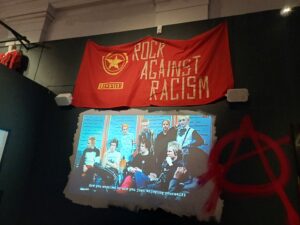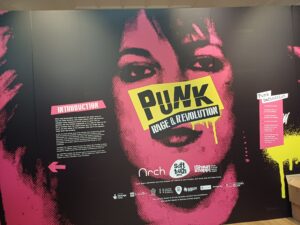Exhibition
Punk: Rage & Revolution, Leicester Museum & Art Gallery, Until 3 September. Free entry
Punk culture played an important part in countering fascists, so come celebrate it, says Paul Sillett


If you were at all touched by the ‘punk explosion’ in 1976, this exhibition is a must! It gives an incisive historical overview of those exciting times. How many exhibitions do you know where your ears are serenaded on entry by X-Ray Spex’s glorious Oh Bondage! Up Yours! ?
The organisers have got it just right: from the economic, social and political backdrop of those hard times to the essential battle against the nazi National Front (NF). The oral histories of Leicester punks, who have put body and soul into this project, are central. There are plenty of examples of humour and mockery with which various old farts were dealt with at the time. One such hilarious example can be seen in archive television footage of TV presenter Bill Grundy being upstaged by the Sex Pistols, who were none too polite when interviewed by him on air. His career never recovered.
Much of the financial backing for the exhibition has come from local businesses – and the irony of the involvement of certain investors will not be lost on visitors. But this has not resulted in a safe or cosy representation of those times – far from it – so thanks to those who have supported this warts and-all perspective.
Although some punks wore swastikas, this was by far outweighed by the majority of punks, who supported groups, such as The Clash, who spoke out against this cheap and dangerous sensationalism. John Lydon, aka Johnny Rotten of the Sex Pistols, also railed against the NF (sadly a rebel no more, he was spotted wearing a Trump MAGA T-shirt in 2020). This mattered – and is one of only a few omissions here.
The punky/reggae party that blossomed in the 1970s – and the corresponding Rock Against Racism/Anti-Nazi League (RAR/ANL) mass movements – are well captured. The RAR fanzines created by Temporary Hoarding in punk style and an assortment of button badges illuminate the mood of those rebellious days.
Given the prevalence of racism at the time, it could all have been very different. There was a struggle to rid punk culture of the swastika. If you were a punk, the choice was clear: take a stand against the NF and other nazis, who saw the punk cultural scene as promoting ‘degenerate music’, or cop out. Fortunately, most punks, inspired by their cultural heroes, had the right attitude and made the right choice.
The ska music promoted by the 2 Tone Records label had its own punky/reggae mix, which of course grew out of punk. A roundtable discussion as part of the exhibition between those behind the music sparked a fascinating discussion about the supposed ‘fascist’ element of punk.
Along with the activities of RAR/ANL, the exhibition features musicians The Clash and Tom Robinson, as well as Leicester’s own cultural heroes – street photographers and punk fashion trendsetters such as Stephane Raynor, David Parkinson, Helen Robinson and Juliana Sissons. They were part of a push to marginalise NF fascists trying to subvert punk subculture to their own ends.
An emphasis on female empowerment and black women punks is to be welcomed. It was fitting that the original X-Ray Spex saxophonist, Lora Logic, was there to cut the ribbon on the first night, opening the doors to the exhibition’s treasure trove.
The variety of original material alone is worth a visit and includes artwork by Jamie Reid, whose 7-metre mural tells the story of punk. The expensive clothes sold in the King’s Road by Seditionaries and Boy are heavily featured. Amorality and shock was ‘the point’, but at the opening brilliant panellist Sandra Baum commented: ‘We couldn’t afford the King’s Road stuff … and made our own. And this was key to the grassroots nature of it all. But the £40 ‘punk’ T-shirts sold by the likes of Zandra Rhodes in 1977 is evidence that the sharks were already circling and looking to turn rebellion into money.
The spirit of those days hits you throughout the exhibition: the good, the bad and the ugly. Many Leicester punks were cultural pioneers, who acknowledge their debt to the movement’s original DIY ethos.
Anti-fascists will find much of value and pleasure here. For some, it will bring back memories. What is encouraging is the number of young visitors whose remarks in the comment book (which contains over 1000 messages) talk of the exhibition’s power and what it means to them.
This is wonderful blast of history. Don’t miss it!
- The Rage & Revolution project: https://rageandrevolution.co.uk
- Northampton Museum and Art Gallery will also be hosting a Punk: Rage & Revolution exhibition later this year
